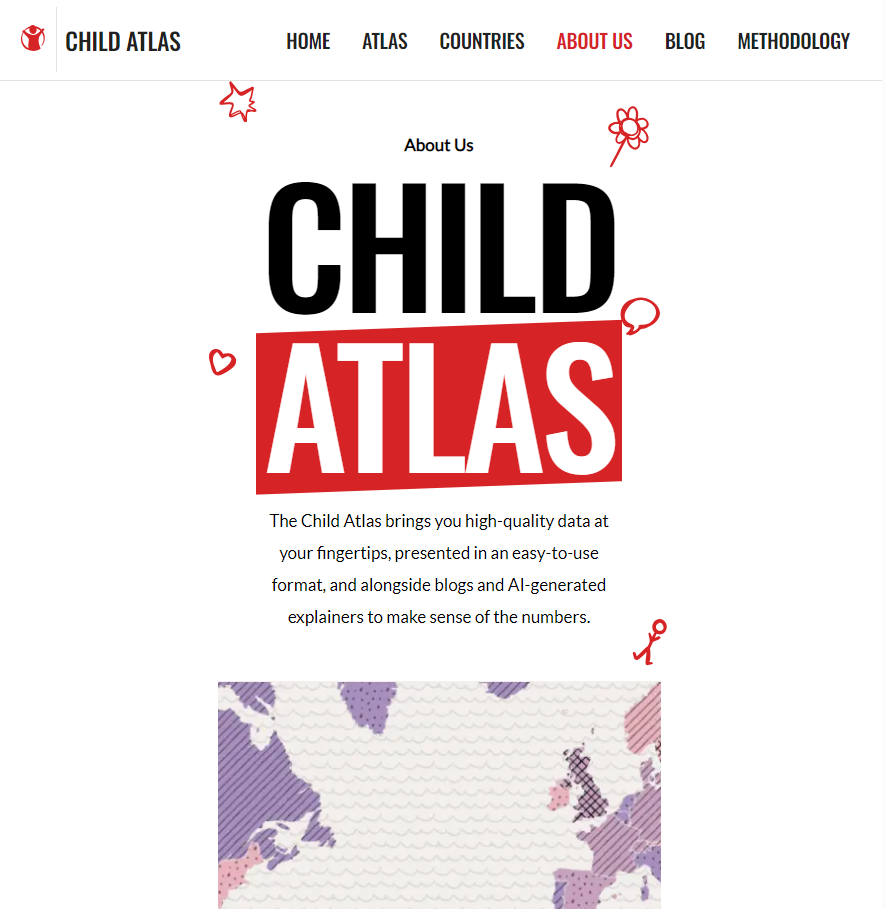Understanding Children’s Lives Through the Power of Data
Share:
The Child Atlas is Save the Children's new data platform to visualise, compare, analyse and understand children’s outcomes globally. The platform puts high-quality, publicly available data at your fingertips. For the first time, we bring together population-based data on key child development outcomes across multiple thematic areas in one integrated platform. This is complemented by data on risks and crises, public policies and financing decisions, and other contextual information.
Photo: Child Atlas - Screenshot 2024
Data is Essential to Deliver Children's Rights
With less than 7 years left, the world is way off-track to reach many of the Sustainable Development Goals for children set out in the 2030 Agenda for Sustainable Development. Progress for child rights is being threatened by multiple, overlapping crises with disproportionate impacts on children’s lives. Data to understand this situation is crucial: it helps us to make better decisions, allocate resources effectively and hold policymakers to account for their actions.
Map inequalities
The Child Atlas includes disaggregated data where available, emphasising the inequalities in key child development indicators between different groups of children. This data is crucial to support the pledge to Leave No One Behind, allowing us to better understand the intersecting experiences of inequality, and to monitor rates of improvement. In both the Atlas and the country profiles you will find disaggregation by gender, place of residence, wealth, disability and sub-national regions. However, the availability of disaggregated data varies considerably by indicator and data source – you are most likely to find disaggregated data for child outcomes measured through household surveys (health, nutrition, education, child protection, poverty).

Child Atlas
2024 · Save the Children UK
The Child Atlas brings you high-quality data at your fingertips, presented in an easy-to-use format, and alongside blogs and AI-generated explainers to make sense of the numbers.
Overlap Data
Data helps us to draw attention to threats to progress, describe emergent risks and crises, and highlight policies and financing decisions that help to advance children’s rights. Importantly, the Child Atlas helps us to better understand how risks, crises and public policies overlap with children’s outcomes across health, education, protection, and broader well-being. For example, is under-five mortality more concentrated in countries with lower coverage of basic health services? (The answer seems to be yes, as the platform shows. Although we can only show correlations, not causality!)
Being able to directly compare child outcomes with potential risks (climate, conflict, hunger, etc.) or policy choices (e.g. public investment in children) is essential if we want to take a more holistic and systemic perspective on children’s rights. You can do this directly in the Child Atlas by selecting a secondary topic.
Do you want to dig deeper? You will find everything you need (and more) on the Child Rights Resource Centre.

Tackling the climate and inequality crisis for children: Tanzania Data Snapshot
2023 · Save the Children UK
Save the Children’s series of National Data Snapshots exploring data on the climate and inequality crisis is a collection of country briefings to support national advocacy to... View Full Abstract
Hear From Children
A child is not a number. Discover how children describe challenges they face. Throughout the Child Atlas, we worked hard to present data in an easy-to-use format. A growing number of blogs will tell specific data stories, provide methodological backgrounds, or highlight innovative data projects we are working on. We also use AI-generated explainers throughout the Child Atlas to help make sense of the numbers, which are clearly marketed with a small ‘AI’ icon. While these help to explain the data in more detail and draw out some key insights, this is an experimental feature and sometimes they are getting things wrong (so please check any such statements).

Realising the Pledge to Leave No One Behind
2016 · Save the Children International
The Pledge to Leave No One Behind, enshrined in the 2030 Agenda for Sustainable Development, has the potential to spur unprecedented change for the world’s poorest and most... View Full Abstract
Join us in our mission to understand and advocate for children’s rights by exploring the Child Atlas today.
The resources you find, upload, and share with us on the Child Rights Resource Centre matter, and they are further utilized for other projects. Don’t keep knowledge to yourself; share it with our worldwide community today! Easily contribute by using our upload form or contacting us at resourcecentre@savethechildren.org.
We’ll see you in the virtual aisles of our library!
Share
Link
